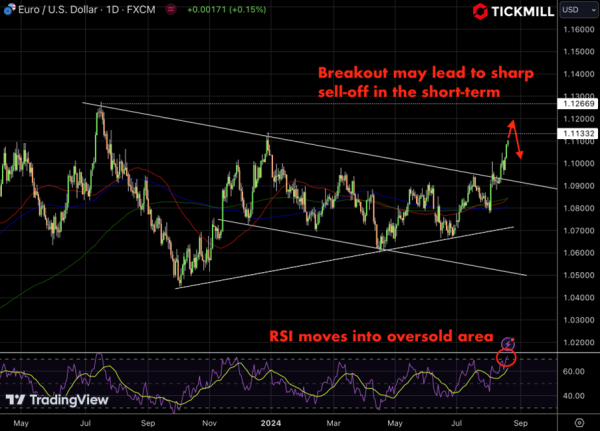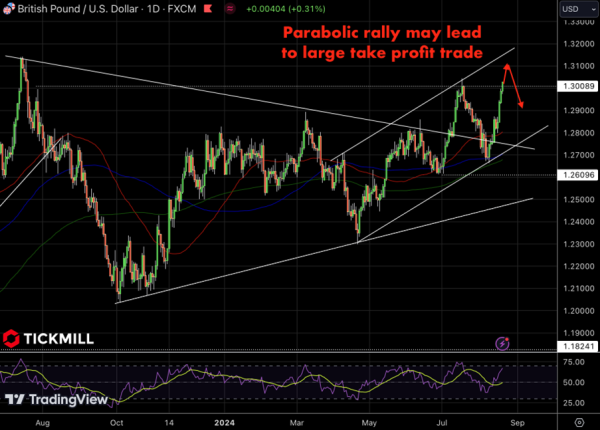A Crucial Week for the US Dollar: Can Dollar Bulls Hold the Line?
The US dollar is once again in the spotlight on Tuesday. Following a bruising session on Monday, the Greenback finds itself under pressure, sliding further against a basket of major currencies, with the EURUSD challenging the 1.11 level for the first time since December last year. The upcoming Jackson Hole Symposium in Wyoming is the key event on every trader’s radar, with Fed Chairman Jerome Powell’s anticipated speech poised to set the tone for the US dollar’s trajectory in the coming weeks:

The market’s mood has shifted considerably, with a notable reduction in safe haven flows towards the US dollar. The prospect of a soft landing for the US economy—where a recession is avoided, and economic growth gradually normalizes—has gained traction among traders. The dearth of major economic data leading up to Jackson Hole has given the markets breathing room, allowing optimism to take root.
This week, the FOMC minutes and Powell’s commentary at Jackson Hole are set to be the main drivers for the US dollar. Market participants are eager to dissect the FOMC minutes for any hints on the Fed’s future policy stance. US interest rate futures currently indicate a 77.5% probability of a 25-basis point rate cut in September, with varying odds for further cuts in November.
The implications of Powell’s speech cannot be overstated. With the US Dollar Index (DXY) teetering on the brink of erasing its 2024 gains, dollar bulls are on high alert. A dovish tone from Powell could see the Greenback losing ground further, potentially flipping its year-to-date performance into negative territory. On the other hand, a hawkish stance might offer some reprieve, although the market’s current risk-on disposition suggests that any upside could be capped.
In the crosshairs of the US Dollar’s weakness is the British Pound, which has surged to a fresh monthly high, breaking through the 1.30 psychological barrier. The GBP/USD pair is capitalizing on the US dollar’s frailty, driven by the growing consensus that the Fed will initiate rate cuts in September. This sentiment has overshadowed positive developments in the UK’s consumer price pressures, where the services inflation gauge—a critical indicator for the BoE—eased to 5.2% in July.

Despite this, the slowdown in price pressures within the UK’s service sector hasn’t been sufficient to compel the BoE to reverse course on its monetary tightening. However, it has opened the door to potential sequential rate cuts down the line, with a 38% probability now attached to such a scenario according to market estimates. For more concrete guidance, traders will be closely monitoring BoE Governor Andrew Bailey’s speech at Jackson Hole, with particular attention to his views on wage growth and the potential for re-accelerating inflation.
Before Bailey takes the stage, the UK’s preliminary S&P PMI data for August will be another key release, with expectations for the Manufacturing PMI to hold steady at 52.1 and an uptick in services activity. These data points will provide further insight into the UK’s economic resilience and the BoE’s likely response.
As we navigate through this critical week, the US dollar stands at a crossroads. The combination of reduced safe-haven demand, optimism about a soft landing for the US economy, and the anticipation of dovish signals from the Fed are all weighing heavily on the Greenback. For dollar bulls, Powell’s speech at Jackson Hole will be a make-or-break moment.